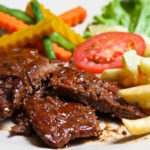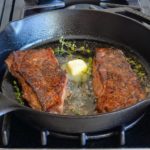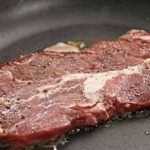The buffet style (à la carte) is preferred by many people for gatherings and events because they can choose their favorite dishes and know the cost in advance. The “three before four after” rule is often mentioned when going to a buffet with the goal of avoiding overeating, wasting food, or feeling cheated in terms of the cost.
The “three before four after” rule when going to a buffet
With these rules, you will not overeat and will not be worried about the cost when going to a buffet.

With the “three before four after” rule when going to a buffet, you will not overeat and will not be worried about the cost. (Photo: Design & Build)
The three before rule: Three dishes to eat first
Premium seafood: Seafood is usually more expensive, so restaurants usually serve it in limited quantities. Meanwhile, many people love this dish, so they often focus on attacking the seafood counter, causing this area to run out of food easily. Therefore, this is a dish you should eat first when using the buffet service.
However, you should only eat a moderate amount because eating too much seafood at once is not good for your health. Besides, there are many other delicious dishes waiting for you to enjoy and many others also want to eat seafood.

Premium seafood is a dish to eat first, following the “three before four after” rule when going to a buffet. (Photo: Useful)
Steak, grilled dishes: Steaks, grilled ribs, chicken feet, grilled wings, roast meat… are also expensive and suitable for the preferences of many people, so you should get them early.
Nem, cha: Nem cua (crab spring rolls), cha oc (snail sausage), cha tom (shrimp sausage) are delicious dishes but you should also eat them early to fully taste their flavors. These dishes taste better when eaten in moderation, so you shouldn’t take too much.
The four after rule: Dishes to have after
With the “three before four after” rule when going to a buffet, you should enjoy the following 4 dishes after eating seafood, grilled dishes, and nem cha:
Salad: This dish helps refresh your taste, balance your palate, and provide comfort after eating high-protein and high-fat meat and food.
Sushi: Sushi also provides carbohydrates but is healthier than fried rice or stir-fried noodles because it contains less oil and is made from nutritious ingredients.
Fruit juice: A glass of fruit juice helps you feel comfortable and regain a pleasant taste after eating nutrient-rich dishes.
Desserts: To avoid consuming too many calories and feeling tired from overeating, you should not eat too many desserts, even if there are dozens of types of tea, pastries, and fruits on the counter. Choose a few best and favorite dishes or rare dishes that you rarely have the chance to try elsewhere and eat a small amount of each.

To avoid consuming too many calories, you should not eat too many desserts and only eat a small quantity. (Photo: Fingerfood)
Tricks to maximize the profits of buffet restaurants
These are business tricks of buffet restaurants that customers rarely know.
Use small plates
Small plates make diners unable to take a lot of food at once, and when they are satisfied, they will not have the desire to continue getting more food. Even while hesitating about whether to get up or not, the feeling of fullness becomes obvious, and they will decide to stop.
Fancy names for cheap food
Using fancy names for familiar, cheap, and filling dishes is a trick to optimize the profits of buffet restaurants. Customers will be curious to try them, and their stomachs will not have enough space to eat more dishes.
Lighting trick
Many buffet restaurants use pale yellow lights to stimulate the visual senses in low-cost food areas. These lights make the food look more appetizing and are taken more often. White lights are used for dining areas to encourage customers to focus on eating, so they will leave earlier.
Delay the serving of expensive dishes
While low-cost dishes are always fully stocked, the counter serving expensive dishes such as sashimi, steak, grilled food, premium seafood always has a slow serving speed. Customers often have to wait longer or encounter the situation of running out of food when coming to this area. This is intentional, the staff deliberately delays providing more food and seems busy with other tasks, occasionally adding food only after a long time, making many customers unable to wait and move to another counter.
Place cheap dishes next to expensive ones
A cost-saving secret of buffet restaurants is to divide luxurious dishes into small portions but around them are some cheap side dishes such as soup, salad, bread… beautifully presented. Many restaurants do not display expensive dishes on the counter but have staff serve them at the table only once.
Source: VTC news


































